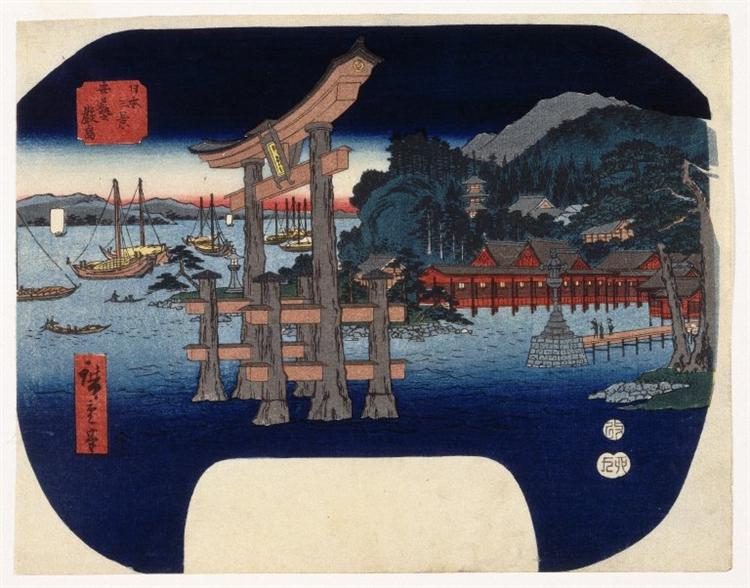Beschreibung
Utagawa Hiroshige's "Itsukushima In Aki Province - 1858" is a notable example of the ukiyo-e style, a genre of Japanese prints and paintings that flourished between the 17th and 19th centuries. One of the foremost artists in this tradition, Hiroshige manages to capture the essence of nature's ephemeral beauty, a recurring theme in his work. This painting, in particular, not only depicts a landscape but also highlights man's interaction with his environment.
The composition of the work is a masterful example of the landscape technique that characterized Hiroshige. In the foreground, we see a series of boats sailing serenely through the waters, suggesting an intimate connection between humanity and the sea. The diagonal arrangement of the boats guides the viewer’s gaze towards the background, where the sacred Itsukushima Shrine stands, highlighted by the famous torii that emerge from the water, symbolizing the entrance to a spiritual realm. This use of diagonal elements not only creates a sense of depth, but also brings dynamism to the scene.
The treatment of color in this work is remarkable. Hiroshige employs a palette that combines soft, subtle tones with more vibrant accents, creating an atmosphere of calm and serenity. The blues of the water, contrasting with the warm hues of the sunset on the horizon, give the whole a sense of harmony. The nuances of the sky, with fluffy clouds that blend with the light, evoke a melancholic beauty that invites contemplation. This attention to color is a testament to Hiroshige's talent for evoking emotions and atmospheres through art.
Despite the presence of human elements, the painting conveys the preeminence of nature, a fundamental principle in Japanese aesthetic thought. The figures of sailors and travelers are mere details compared to the majestic landscape that surrounds them. This approach suggests a reverence for nature and the environment, a characteristic inherent in ukiyo-e, where sumos are often shown against a backdrop of stunning natural beauty.
Another interesting aspect of this work is its historical and cultural context. The Itsukushima Shrine, located on the island of Miyajima, is a sacred site that has attracted numerous pilgrims over the centuries. The depiction of this iconic place not only sublimates its beauty, but also highlights the deep spiritual connection that Japan has with its landscapes and mythology. Hiroshige succeeds, in this sense, in reflecting the spirit of his time, when tourism and appreciation of natural landscapes were booming, especially during the Edo era.
Through “Itsukushima In Aki Province,” Hiroshige not only offers a visual representation of an iconic Japanese landscape, but also captures the essence of a moment in time, inviting the viewer to reflect on the relationship between humans and their natural environment. His mastery in capturing light, color, and form makes this work a landmark of Japanese art, which continues to resonate today as a hymn to the beauty and transience of life.
KUADROS ©, a famous painting on your wall.
Hand-made oil painting reproductions, with the quality of professional artists and the distinctive seal of KUADROS ©.
Painting reproduction service with satisfaction guarantee. If you are not completely satisfied with the replica of your painting, we will refund 100% of your money.

